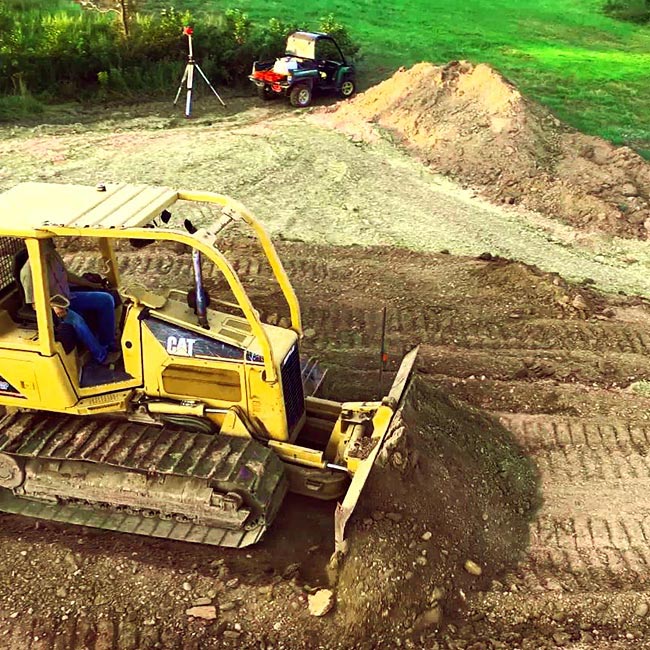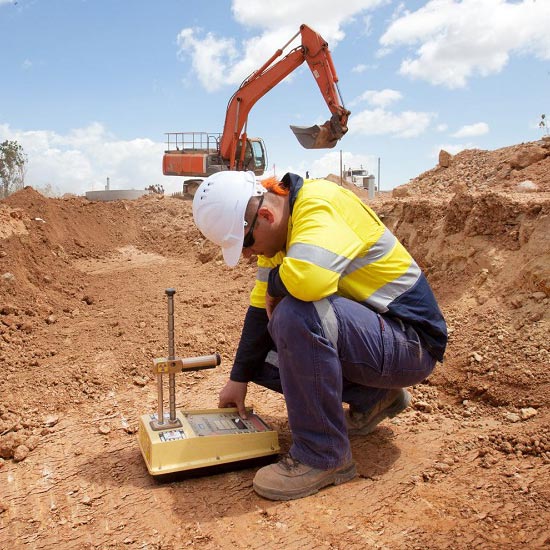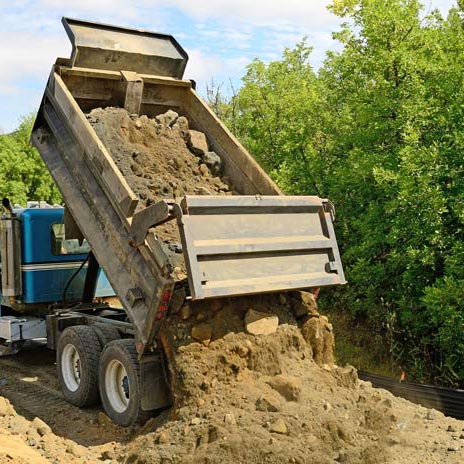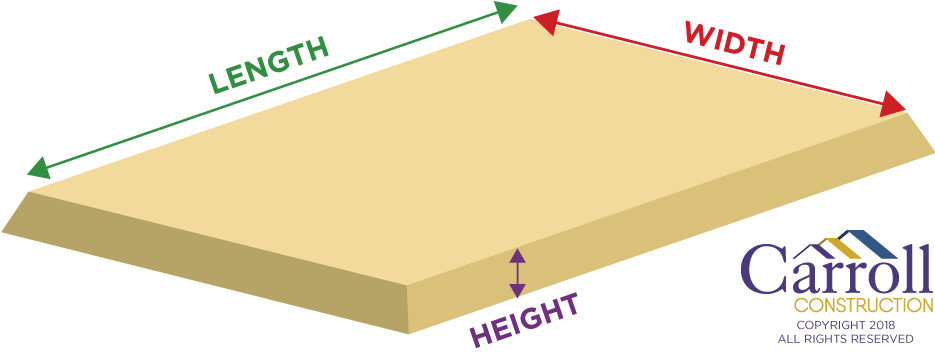The Dirty Secrets About Dirt Work
As simplistic as it sounds....

Dirt might seem basic, but it’s the single most important element in a home’s foundation.
We’re not talking about the planet—just good ol’ soil. It literally supports every part of your house, and when residential dirt work is done poorly, the consequences are expensive.
In this guide, you’ll learn:
- How to spot shady residential dirt work practices
- What proper site prep really involves
- What real homeowners experienced when dirt work went wrong
- And find out how you can calculate the dirt you’ll need for your project with our Dirt Yardage Calculator
Not all dirt-prep contractors are created equal—some just push dirt and push problems to you.
In this article, we compiled a few true stories from folks who had truly awful experiences with a dirt work contractors. To fully understand how bad those experience were – and to help YOU avoid the problems these people encountered – it’ll help to know a few steadfast rules that apply when prepping for the foundation of a home.
Please sign up to get FREE ACCESS to our popular Dirt Work Calculator. You will receive the password via email within minutes.
How Dirt Work Should Be Done
- Start with undisturbed ground—your slab needs stability.
Avoid steep slopes unless fill is properly engineered.
Permits & plot plans may be needed.
Fill dirt should match the native soil.
Soil testing labs need a proctor sample—get it in a 5-gallon bucket.
Call the testing company before the contractor starts work.
Compact the fill in layers—aim for 95% compaction or better.
Wet or dry dirt won’t compact—timing matters.
Skipping this phase costs more later—often 10x more.
When a Buddy Deal Goes Bad (Real Story)
It’s natural to want to support friends in business—especially when they offer you a deal. But when it comes to dirt work, cutting corners with the wrong person can lead to expensive consequences.
One homeowner learned this the hard way after hiring a buddy who owned a local dirt work company. The homeowner asked him to dig a pond, build a 100×100 house pad, grade the land, and install swales for drainage. The city even required a permit and plot plan for drainage compliance. The buddy promised to handle everything.
What Went Wrong — and Why It Matters
Just three days later, the dirt work was "done." The homeowner assumed his friend handled everything properly, so he wrote a large check. Unfortunately, that trust turned into one problem after another.
Problem #1: The House Pad Was Too Small.
Even though the homeowner placed flags to mark the pad size, early construction revealed it wasn’t large enough.
Problem #2: The Dirt Wasn't Compacted!
Once the crew poured the slab, the plumber noticed a problem. When the homeowner requested the compaction report, he discovered the contractor had forged it. The site never passed inspection, and the builder was left with no choice but to install $8,000 worth of concrete drill shafts to stabilize the foundation.
Problem #3: The Deal Fell Apart
To settle the issue, the homeowner and his friend agreed on a trade: 50 loads of dirt for another area of the property. But after only 22 loads, the friend walked away—telling the homeowner to take it to court if he wanted the rest.

“I made some mistakes, but I learned valuable lessons.
If I had to do it again, I’d let my contractor handle the entire process.
They know what to look for—and how to hold subcontractors accountable.”
The Bait-and-Switch Estimate Scam
Everyone loves a good deal—but if a price seems too good to be true, it probably is.
Some contractors rely on a shady tactic known as bait-and-switch pricing:
- They submit a bid that’s dramatically lower than competitors to win your business.
- But once the job begins, they claim the original estimate was off—and demand more money to finish.
- At that point, most homeowners feel stuck. Rather than halting the job, they cave and pay the new (much higher) price.
It's not just frustrating—it’s intentional.
That’s exactly what happened to one homeowner who reached out to us. They received several quotes for their residential dirt work and grading, averaging around $10 per yard. But one company stood out by offering $6 per yard—claiming they owned their own pit, trucks, and equipment, and could pass on the savings.
The family went with the lower bid. But as work progressed, the contractor kept bringing in more and more dirt, insisting the site needed extra fill.
The real issue? There was no way to verify how much dirt was actually delivered. No one weighed the trucks, so the homeowner had no way to verify the actual yardage. The contractor quoted under $10,000, but the final cost ballooned to over $20,000—twice the original estimate.
“They said owning their own pit meant lower costs.
But when the trucks kept coming and the invoices kept growing, we knew we’d made a mistake.”
Please sign up to get FREE ACCESS to our popular Dirt Work Calculator. You will receive the password via email within minutes.
When Paperwork Gets Just as Messy as the Job Site
Not every subcontractor is skilled at both dirt work and office work. Administrative tasks—like estimates, invoices, and change orders—often fall by the wayside with small independent firms.
Unfortunately, poor paperwork can cause just as much stress as poor dirt prep.
This homeowner's experience says it all:
Their house pad required less fill than originally estimated. When they pointed this out, the contractor agreed and manually revised the invoice. He even included the check number and date on the “customer copy” to confirm it was paid.
Problem solved? Not quite.

A few weeks later, the homeowner got a letter from the contractor’s attorney, demanding the difference between the original (pre-adjustment) amount and what they had actually paid.
The contractor never documented the updated invoice—or he lost it entirely. Either way, the homeowner had to scramble to find proof of payment and invoice edits—just to avoid paying twice.
“We weren’t trying to short him—he just didn’t update his own records.
It was a complete mess, and we had to dig up check images and copies of the invoice to clear it up.”
This likely wasn’t malicious—it was just disorganized. But it shows how important it is for homeowners to keep their own records, understand the scope of work, and use a builder who holds subcontractors accountable.
How to Protect Yourself From Dirt Work Disasters
These stories may feel overwhelming—but they’ll also help you prepare wisely.
Whether you're working with a contractor or managing parts of the build yourself, these best practices can help you spot the red flags, ask the right questions, and protect your investment from the ground up.
Smart Steps to Take Before and During Residential Dirt Work:
Research contractors thoroughly.
Check reviews on Google, Facebook, and other platforms. Ask past clients specific questions about communication, billing, and jobsite behavior.Verify general liability insurance.
Require proof, and request that you be named as an additional insured on the certificate. That certificate should come directly from the insurer, not the contractor.Hire a separate soil testing company.
They’ll give you detailed instructions to prepare your site and perform necessary proctor and compaction tests.Plan to be on-site when the trucks arrive.
If you’re being charged by the load, count the trucks yourself or designate someone who can. Address discrepancies immediately.Schedule compaction testing.
Most jurisdictions require testing every 8" to 12" of fill added after topsoil removal. Don't skip this step—inspections help prevent costly future repairs.Order a geotechnical report
if your house pad will be elevated more than 3 feet. It’s a small investment that prevents major guesswork.Calculate your own fill needs.
Carroll Construction offers a free Dirt Yardage Calculator to help estimate how much dirt your pad really needs. It even factors in:Topsoil removal depth (8", or 0.67 ft)
Tapered slope around the pad
Common oversights in contractor estimates
“Most of these problems start because homeowners don’t know what to ask.
The more informed you are, the fewer surprises you'll face.”
The Smartest Move? Let Your Builder Handle It.
Managing residential dirt work seems simple—but it involves technical decisions that affect your home for decades. A bad pad design can lead to cracks, drainage issues, and foundation failure. Repairs often cost far more than proper prep ever would.
Believe it or not, site prep affects everything from structure to energy efficiency for solar orientation of the home. That’s why we recommend also planning for energy performance early, starting with dirt work.
That’s why you should let your builder take the lead on this phase.
A qualified builder will:
Schedule testing at the right time
Collect proper documentation
Hold vendors accountable
- And balance cost and quality to protect your budget
At Carroll Construction, we take full responsibility for the foundation prep. You’ll always know what’s happening, and we’ll explain every step—from soil testing to slab pour—so you can build with confidence.
Estimate How Much Dirt You Actually Need
Our Dirt Yardage Calculator helps you estimate how much fill you’ll need based on your home’s dimensions, pad height, and slope requirements. It accounts for:
8" of topsoil removal
Sloped perimeter around the pad
Standard dirt compaction assumptions

Ready To Talk With Someone About Your New Home?
You can reach us during working hours at (225) 335-2334
Hours: Mon-Fri, 7:00am - 3:30pm
Closed Saturdays & Sundays
After hours? Send us a message request a call back.
You can even schedule a call at a time of your choice.




